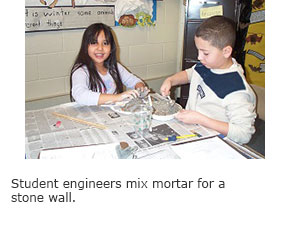This month on the EiE Blog we’re sharing candid videos from elementary classrooms that show how early experience with engineering helps students develop “engineering habits of mind,” or ways of thinking that can be the foundation for lifelong learning. Today we focus on a habit of mind that some sociologists call “agency.”

Agency: The Power to Decide
Agency is the habit of thinking that you have the power to make your own choices. When you have agency, you feel that you can improve your life . . . and the world around you. And when you believe you can change things, that belief gives you the power to act. Within the framework of “engineering education in the elementary classroom,” we consider students to be demonstrating agency when they self-identify as engineers.
Getting Ready to Engineer
The video presented here is just one moment in one day in a second-grade classroom. The students have been working on EiE’s materials engineering unit, “A Sticky Situation: Designing Walls.” They started by reading a story about a girl who wants to design a wall to keep rabbits out of the school vegetable garden. Then, they conducted a set of controlled experiments to evaluate what materials make the best mortar for a stone wall.
Now they’re about to design and build their own walls. They’ll test the strength of the walls, and–based on those tests–improve their design solutions. All of these activities are framed by EiE’s five-step Engineering Design Process (EDP), an age-appropriate version of the process that working engineers use to solve a problem.
But before the students start the next lesson, Ms. Neat asks her students whether they feel like materials engineers. This is a more significant question than it might seem at first blush.
The Crisis: Not Enough STEM Students
Currently, American universities and colleges don’t graduate enough STEM-literate students to fill the STEM jobs available. This state of affairs is considered a national crisis. Many factors influence a student’s decision to pursue and achieve a career in engineering, among them whether the student has a parent or mentor who’s an engineer, whether teachers are supportive, and whether the required courses are engaging.
Another important factor is that, in order to grow up to be engineers, students must be able to imagine themselves as engineers. They need experiences that spark them to daydream a future where engineering is their job . . . that allow them to look in the mirror and say, “Look at me. I’m already an engineer.”
Minority Students Need Equal Support
According to a recent brief from Change the Equation, students who are African American or Hispanic are too often prevented from taking the first step on the pathway to an engineering career. In particular, they are less likely to be encouraged by their teachers or parents to consider engineering: nearly two-thirds of white fifth graders identified as “high-achieving” enroll in algebra in eighth grade, but only a third of high-achieving African American fifth-graders do. This failure to identify and encourage minority students who have the potential to pursue engineering careers is a shocking waste of talent—and essentially unfair.
The students in the video presented here attend an elementary school in Florida’s Broward County School District City that is 72 percent African American, 19 percent Hispanic, and 5 percent multi-racial. More than nine in ten students receive free or reduced lunch.
But this is also a magnet school where STEM learning is a priority. And the teachers at this school are doing more than just teaching STEM content and practices; they’re actively working to develop their students’ engineering habits of mind.
Watch what happens when Ms. Neat holds up that mirror—when she asks her students whether they feel like engineers. It’s a beautiful demonstration of agency at work.
Engineering is Elementary is a project of the National Center for Technological Literacy at the Museum of Science, Boston.








